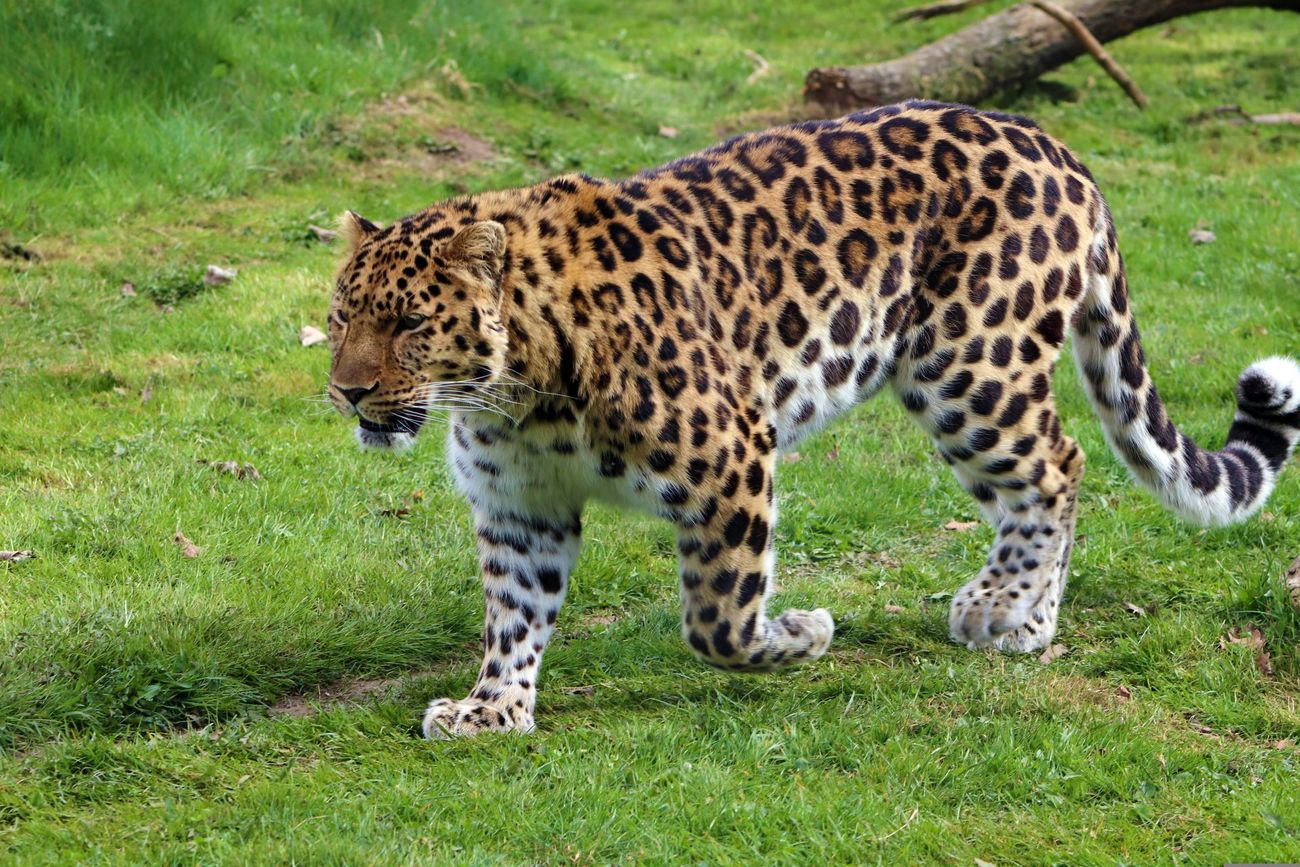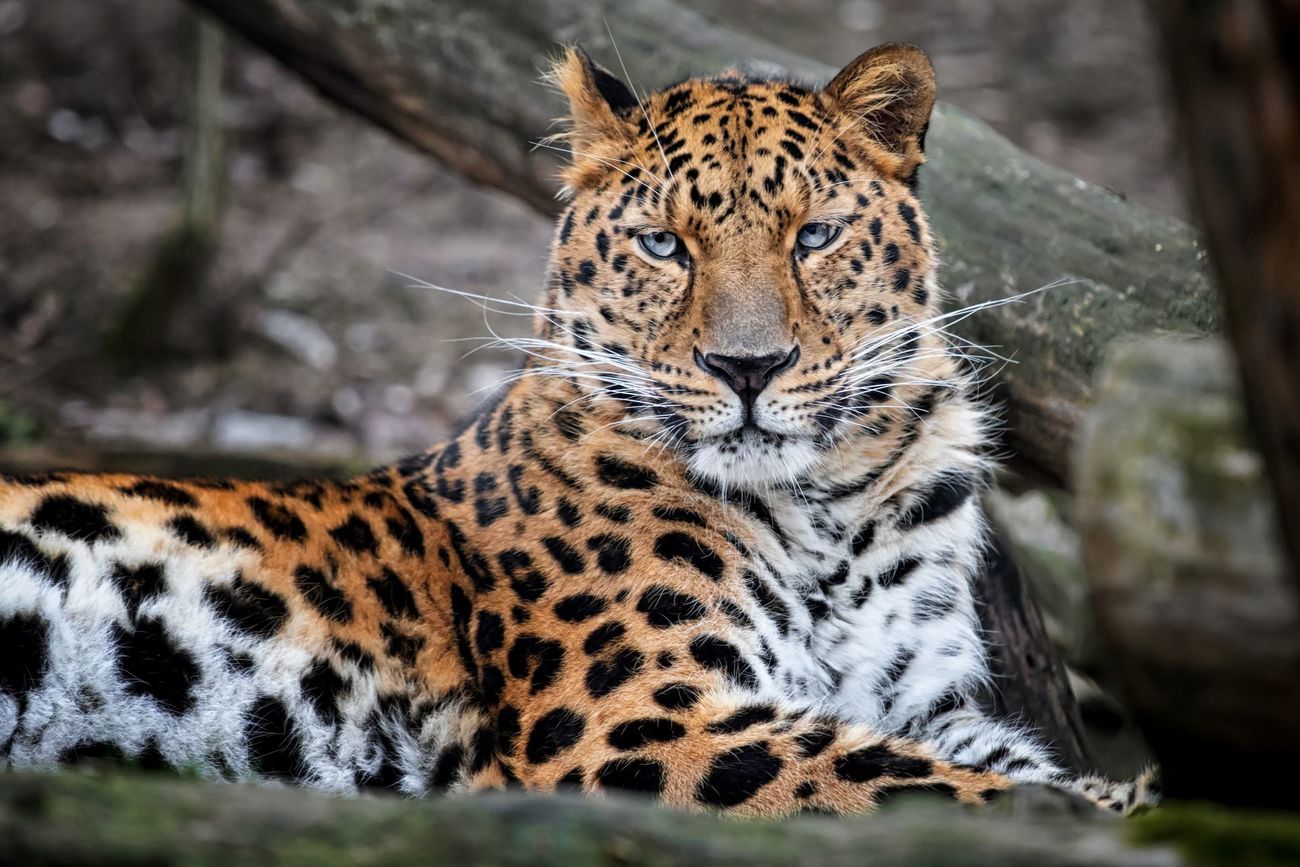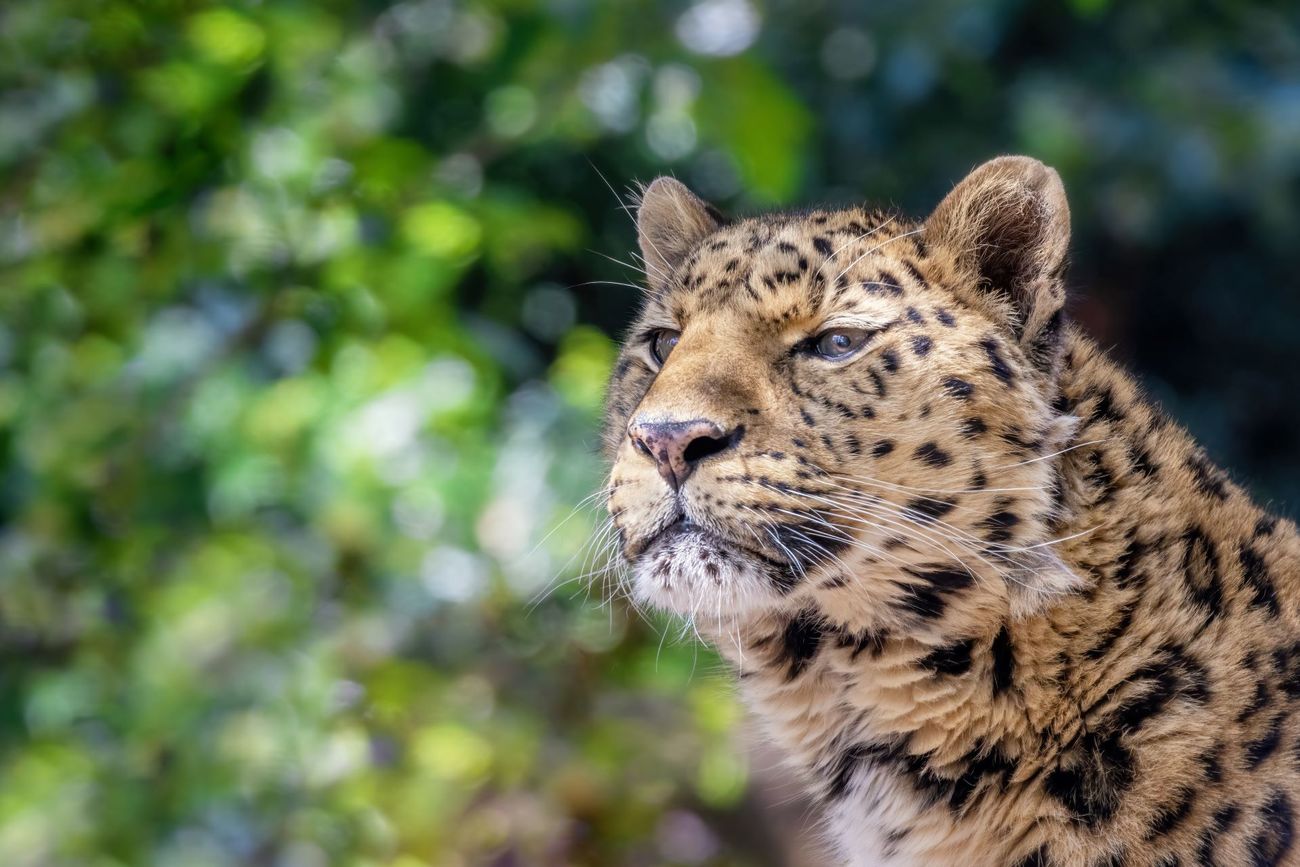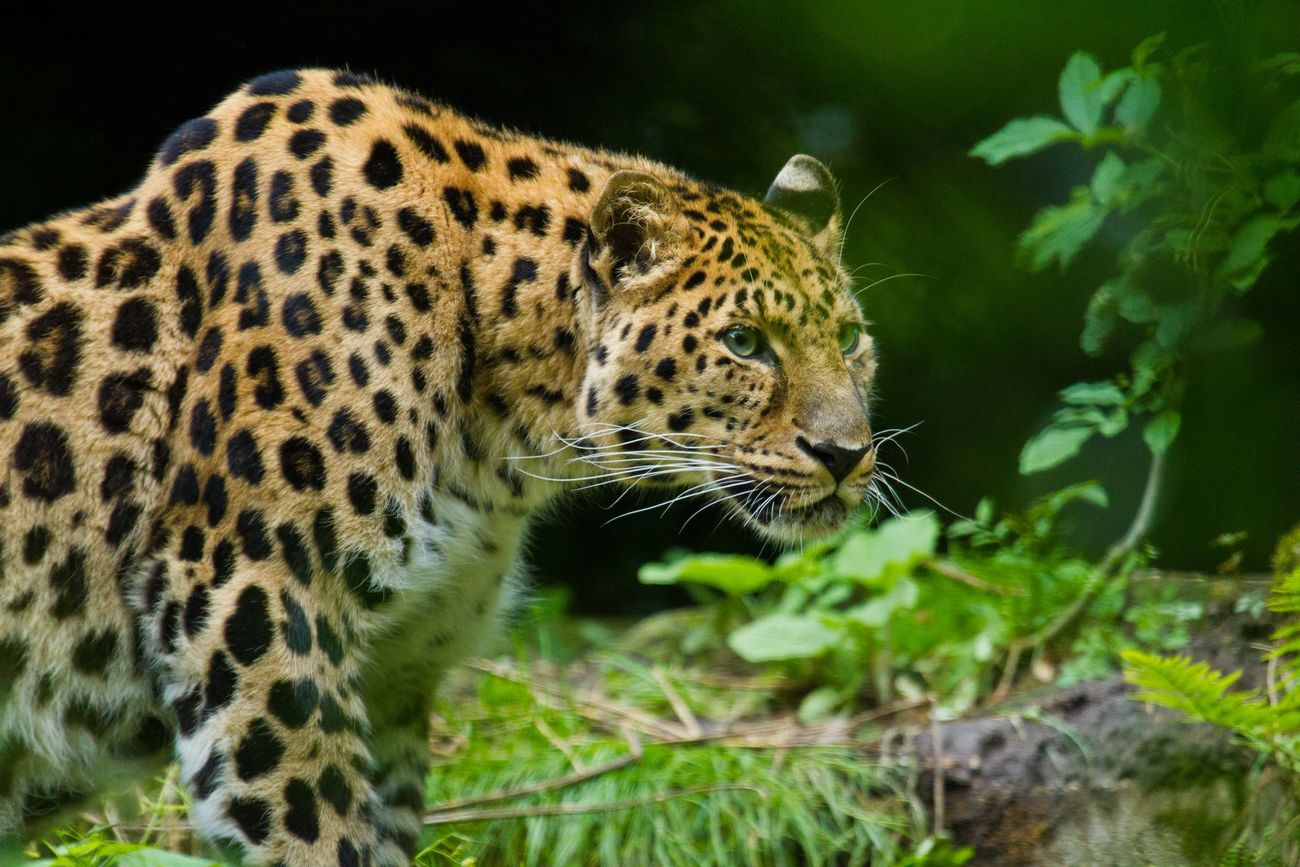Amur leopards
Amur leopards are a subspecies of leopards that have adapted to live in the forests and mountains of eastern Russia and northern China. They’re named after the Amur River, which flows along the border of the two countries, right where the leopard population is concentrated. Although they don’t live in Arctic conditions, the weather in their range is cold and harsh in the winter, so the leopards have developed specific traits to help them survive.
Amur leopards have longer legs and wider paws than other leopards, helping them walk through snow at a higher speed and without using as much energy. Their fur changes throughout the seasons, from a darker yellow in the summer to a lighter shade in the winter. They keep their spots year-round, and each individual has its own unique pattern. Their fur also grows from around two and a half centimetres to seven centimetres to improve insulation during snowy weather.
Amur leopards are big cats who live solitary lives and occupy large territories to lower competition for food. Though the home ranges of females sometimes overlap, males prefer to stay separated and signal their presence through territorial calls to avoid confrontation. Breeding can take place at any time of year, and female leopards usually give birth to two or three cubs at a time. The cubs are blind and extremely small when they’re born, so the mothers will keep them hidden for several weeks to make sure they survive.
While the number of Amur leopards in the wild is currently very low, conservationists are hopeful because the number of females is double that of males. The males can impregnate multiple females and produce lots of young.
An Amur leopard’s habitat is dominated by coniferous-deciduous forests where it’s easy for them to rest in the trees and hunt small to medium-sized prey. They can’t survive well further north because there’s too much snow cover, and they can’t live in the grasslands that surround the forests. They mainly hunt at night and have excellent night vision that they use to stalk their prey. They watch animals from afar and slowly sneak towards them before using a burst of energy to leap forward in ambush.
As top predators, Amur leopards have a large impact on their ecosystems. They regulate the populations of prey species, which in turn keeps plant life flourishing. By protecting Amur leopards, we also protect their forest homes, much of which is being cleared for human development.
What is an Amur leopard’s scientific name?
The Amur leopard’s scientific name is Panthera pardus orientalis. They are sometimes also known as Far Eastern leopards. Because the Amur leopard is considered a subspecies of leopard, it shares the same Panthera pardus name with orientalis added on the end. Leopards are also often referred to as panthers; the two names are used interchangeably for the same animal.
Are Amur leopards endangered?
Amur leopards are one of the most endangered big cats in the world, and their numbers were pushed as low as 30 individuals during the 1970s. Conservation efforts have raised this number to around 100 individuals in recent years, and most Amur leopards now live in the Russian Land of the Leopard protected area. Despite these improvements, however, they are still considered critically endangered by the IUCN and face threats such as habitat loss, poaching, and inbreeding.
Where do Amur leopards live?
Although most leopards live in African savannahs or Southeast Asian jungles, the Amur leopard subspecies lives in eastern Russia. Historically, they also roamed a large area of northeast China and the Korean peninsula. Today, however, they only inhabit a small area on the border of China and Russia. They live in forests where they can rest in trees and hunt other forest animals.
Threats
Because the Amur leopard population is so small, they face extinction due to threats such as habitat loss, poaching, and inbreeding.

Habitat loss
The forest habitat of the Amur leopard in eastern Russia and northern China has been reduced in recent years by development such as gas pipelines and expanding road networks and railway development, despite it not being a heavily populated area. There is also mining, extraction, and timber overharvesting.
One of the biggest causes of habitat loss is forest fires—not naturally occurring fires, but fires people set deliberately to clear land, often on an annual basis. Too many fires in one place will eventually stop trees from regrowing and turn the environment into grasslands, which are not suitable for Amur leopards. Between 1996 and 2003, 46% of potential leopard habitat in Russia was burned at least once, and as much as 22% was burned again every year.
Poaching
Hunting is very problematic for Amur leopards because they are affected both directly and indirectly. As well as being poached for their skins, Amur leopards are also killed by hunters to eliminate competition for deer and wild boar. If the leopards cause any damage to property, livestock, or domestic animals, they also might be killed in retaliation. However, even when hunters leave the leopards alone, they continue to hunt the leopards’ prey and reduce food availability. The forests are easy to access, and a high number of both working-class and rich Russian hunters travel there to hunt.
Inbreeding
The dangers of inbreeding are difficult to guess and require research, but it could lead to medical issues over time. With such a small population, inbreeding is very likely, and some initial evidence of complications has already been observed. Disease transmission is also a problem that could be caused either by domestic or wild animals in the leopards’ home range. Though disease is a natural part of life, when the population size is so small, it becomes a much more severe problem—and if medical issues become more common due to inbreeding, disease could potentially wipe out the remaining Amur leopards.

FAQs
What do Amur leopards eat?
Amur leopards are carnivores and skilled hunters. Meat is the main part of the Amur leopard diet, and they’re often not picky about the type of animal they hunt. They prey on larger animals such as sika deer, roe deer, and wild boar when they can, but a lot of their diet consists of small kills like weasels, badgers, birds, hares, and mice. They typically hunt at night and watch their prey from afar before making their move.
When they’re ready to pounce, they ambush their prey at speeds of up to 35 miles per hour and sometimes jump down from trees or higher ground. To keep their dinner safe from competition or scavengers, the leopard will keep the kill with them at all times, even dragging it up trees. When they eat, Amur leopards use the sharp papillae on their tongues to scrape every bit of meat from the bones of their dinner.

How many Amur leopards are left in the world?
In the wild, it’s estimated that only around 100 Amur leopards remain. Their historical range has diminished significantly, and they mostly live on the Russia-China border in a protected area. There are also around 220 Amur leopards in captivity in 88 institutions around the world. These institutions work together to keep their breeding programmes as diverse and effective as possible.
How much does an Amur leopard weigh?
Male Amur leopards typically weigh 50-60 kilograms, while females weigh 30-35 kilograms.
How big are Amur leopards?
Amur leopards are similar in size to other leopard species, reaching around one and a half metres in length. However, they have longer legs than other species, which helps them walk through snow more easily.

Why are Amur leopards endangered?
Amur leopards have lost a lot of their historic range and were driven close to extinction by hunting a few decades ago. Now they mostly live in a protected area and are threatened by further habitat loss, poaching, and inbreeding.
How long do Amur leopards live?
Amur leopards can live for around 10-15 years in the wild and up to 20 years in captivity.
What sound does an Amur leopard make?
In 2017, the call of a wild Amur leopard was caught on camera for the first time in Russia’s Land of the Leopard protected area. The male leopard, named Typhoon, was recorded making a territorial call known as ‘sawing.’ This vocalisation is a low and throaty growl that stops and starts multiple times, much like the grating of a manual saw against wood.
Male Amur leopards are fairly territorial, so alerting other males to his presence can save Typhoon from unnecessary confrontations. It’s also a very distinctive call that would be difficult to confuse with a different type of big cat. Aside from territorial calls, Amur leopards don’t vocalise very often because they’re solitary creatures. They also can’t purr like some other types of big cats.

What is a group of Amur leopards called?
Although leopards are a solitary type of big cat, they do still have a few collective nouns. The most commonly used is a leap of leopards, which refers to their jumping ability and the way they hunt by leaping out of a tree and onto their prey. A snarl of leopards is another possible option, more likely to be used if a group of leopards are fighting each other.
How are Amur leopards affected by climate change?
Forest habitats are very susceptible to climate change because small changes in temperature and weather can affect plant life, wiping out some species and introducing others. This affects the animal species that live there, making it difficult for those who have lost food sources and easier for those who eat the new vegetation. These changes eventually impact the Amur leopards because it leads to a decrease in the prey animals they prefer to hunt. Once this happens, areas that were once suitable for Amur leopards become unsuitable, and their habitat shrinks.

How can you help?
Amur leopards face threats of habitat loss, poaching, and inbreeding. IFAW works to protect big cats around the world.